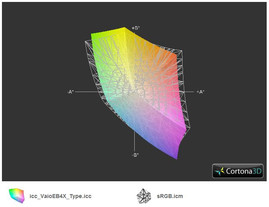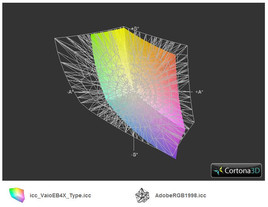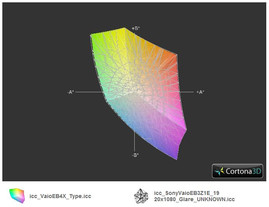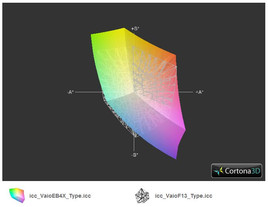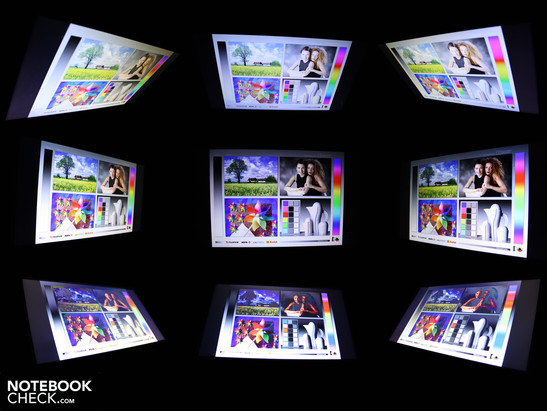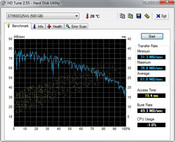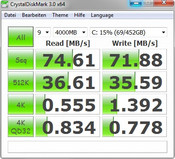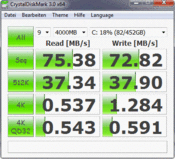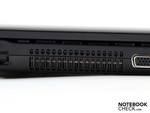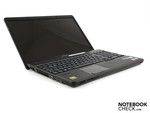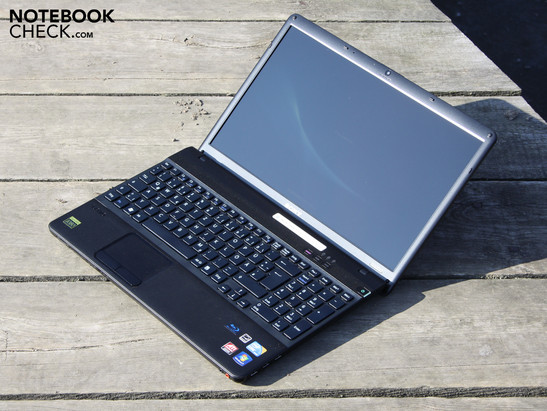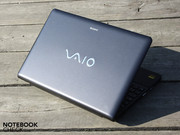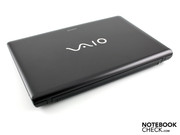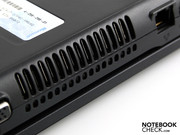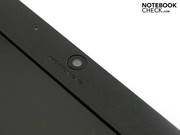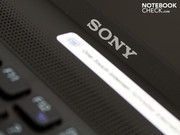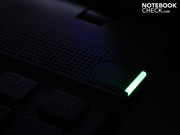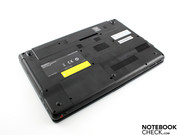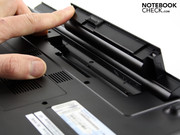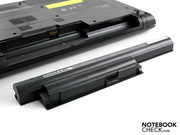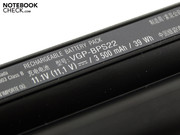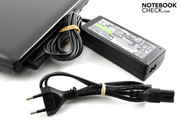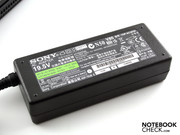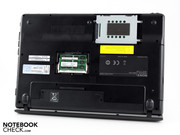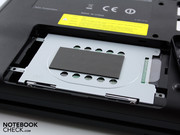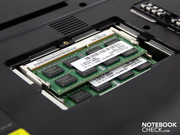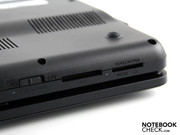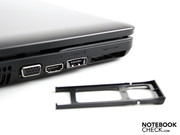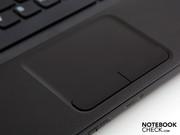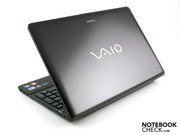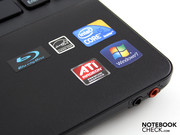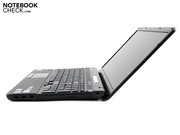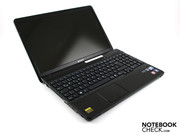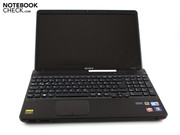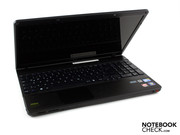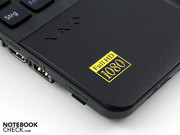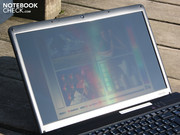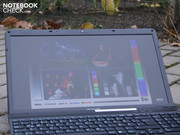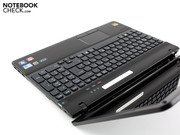Review Sony Vaio VPC-EB4X1E/BQ (FHD) Notebook

Although the predecessor, Vaio VPC-EB3Z1E/BQ, didn't accomplish a total score of very good last November, the FullHD display convinced the testers with a good contrast (551:1), an almost full sRGB color spectrum coverage and stable horizontal viewing angles. The WXGA screen didn't achieve pro qualities, but it created a kind of shining beacon in the sea of inferior, run of the mill screens found in modest consumer laptops.
In view of the attractive starting price of 840 euros, the Vaio EB range's FullHD model remained under close observation. Our readers were just as interested, considering the numerous comments and inquiries. This could be surprising since the Vaio EB looks everything but prestigious with its plain, partly uncoated plastic appearance. If you're looking for a laptop apt for showing off, this Vaio is the wrong choice.
We've opted for a review update on the latest alternative, VPC-EB4X1E/BQ. Although no Sandy Bridge shooting star processor has been employed, an Intel Core i5-480M (2x2.66 GHz) from the 2010 Arrandale architecture is nevertheless inside. Performance leaps in comparison to the i5-460M (2x2.66 GHz) shouldn't be expected. Nothing has changed in terms of graphics. The ATI Mobility Radeon HD 5650, which has been relieved by the AMD Radeon HD 6550M in the meantime, is used. But, at least, the hard disk has grown from 500 to 640 GB (Samsung -> Toshiba).
The most important question in this review: Has the TFT remained to be just as good or is it perhaps even better? We would like to refer to the 100% identically built predecessor, Vaio VPC-EB3Z1E/BQ, for matters of case (looks, material, stability), connectivity (interfaces, wireless modules, software) and the input devices.
Display
The Vaio VPC-EB4's FullHD screen isn't in any way inferior to that of the EB3. As before, we couldn't readout the display model, but the color, brightness and contrast (black value) assessment show an almost identical picture.
Thus, the screen will still be a heavy purchase argument. The VPC EB4 is configured with 1920x1080 pixels (WUXGA). Consequently, the 15.5 incher is especially suitable for HD movie fans (BluRay drive). The high resolution is just as attractive for display screen workers due to its clearly arranged desktop and good contrasts. However, these users might be deterred by the glare type screen – a characteristic that "beginners in HD entertainment" haven't yet been cured of.
Be that as it may, the good contrast of 518:1 will be a delight for everyone's eyes (black value 0.45 cd/m2). The glare type intensifies the color effects, but isn't the reason for the good contrast. Colors always appear brilliant and saturated.
The color spectrum coverage is identical to that of the predecessor, VPC-EB3. The sRGB color spectrum (t) can almost be covered (extended color gamut). The Vaio F13L8E/H's (t) color space, in review at the same time, is almost appallingly narrow. This 16.4 incher plays in a higher league in terms of looks. It is the lowest priced F range model (also FullHD) and has received a matching low cost TFT.
The backlight illuminates the display with an average of 220 cd/m2. Nothing has been changed in comparison to the predecessor model here. There are deviations toward the top. The brightest area is found in the lower center with 236 cd/m2. This brightness divergence isn't visible to the naked eye, though (87% homogeneity).
| |||||||||||||||||||||||||
Brightness Distribution: 87 %
Center on Battery: 233 cd/m²
Contrast: 518:1 (Black: 0.45 cd/m²)
62% AdobeRGB 1998 (Argyll 3D)
88% sRGB (Argyll 3D)
60.4% Display P3 (Argyll 3D)
The glare type characteristic causes difficulties in viewing the screen in sunlight and unfavorable ambient light in the office due to reflections. If you don't want to be without FullHD entertainment on the go, you'll have to look for a shady place. However, the glare type doesn't cause problems in overcast conditions, as the following pictures show.
The horizontal viewing angles meet our optimistic expectations. Ghosting doesn't develop (inverting colors) even at a left or right deviation of 80 degrees (far right/left). However an evident yellow cast turns up at about 45 degrees depending on the color. This was also the case in the EB3 screen. For example, this casting colors a blue sky light green. To illustrate this, we've made a video of viewing angles changes.
The colors aren't as stable vertically and the viewing angles are narrower. Colors start to invert at a deviation of about 30 degrees looking up. We experience blurring of dark areas starting at a deviation of 10 degrees when looking down.
Nevertheless, the FullHD screen is better than most consumer displays. Even the 16.4 inch Vaio F13, in review at the same time, with FullHD doesn't stand a chance in terms of viewing angles and colors against the EB4X1E/BQ or EB3Z1E. However, the Vaio screen doesn't achieve the stability of a desktop TFT (colors stable from all positions).
Performance
The 15.5 incher has received a small update from a Core i5-460M (2x2.53 GHz, 3 MB L3 cache) to a Core i5-480M (2x2.66 GHz, 3 MB L2 cache). The core with a TDP of 35 watts clocks between 2.66 (default) and 2.93 GHz with Turbo Boost. Four threads can also be processed at the same time with Hyper Threading, which is beneficial for multitasking. Every core is supported by a virtual one for this.
The 480M is usually found in non-professional notebooks because it lacks AES, VT-d and Trusted Execution support. These qualities (faster coding, etc.) are reserved for pro laptops with an i5-5xxM. The memory controller incorporated in the CPU can address up to eight gigabyte of DDR3-RAM. 4096 MB of DDR3 main memory are installed in the test device (two RAM modules).
The Intel Graphics Media Accelerator HD in the processor isn't enabled. The dedicated ATI HD 5650 graphics (1024 MB DDR3) can thus not be disabled for energy saving reasons.
Are users at the very forefront with the i5-480M? The EB4X achieves 2.34 points in the multi processor test, Cinebench R11.5 (64 bit). That is only marginally more than i5-460M systems accomplish: 2.27 points (-3%). This performance difference in a per mil range shouldn't play a role in the buying decision. The reason is the slight clock rate difference: 2.53 vs. 2.66 GHz. In comparison, an i3-330M only achieves 1.75 points. In view of this, an upgrade would be worthwhile.
| PCMark Vantage Result | 6082 points | |
Help | ||
One thing that PCMark Vantage shows us is that the total system supplies synthetic computing performance. The result of 6082 points can slightly excel its predecessor (EB3Z1E 5.603 points). This score is impressive since laptops with a quad core i7-740QM (4x1.7 GHz) often don't even achieve as many points, depending on the hard disk and graphics card. We would name the Medion Erazer X6811-MD97624 (5826 points) and the Vaio VPC-F13Z1E/B (5997 points), for example.
The 480M's faster twin cores can keep up with the i7 quad core because its clock rate of 1.73 GHz is quite low. Expressed differently – PCMark Vantage doesn't acknowledge four cores (eight threads) sufficiently. Such systems are apt for multi core applications where a high clock rate isn't important.
The HD 5650 graphics contributes to the high PCMark Vantages score (gaming score: 5232 points). The GPU's impact on PCMark Vantage shouldn't be overrated, though. Even notebooks with chipset graphics can achieve higher total scores (Sony Vaio VPC-B11V9EB: 6180 points).
| 3DMark 03 Standard | 18994 points | |
| 3DMark 05 Standard | 12402 points | |
| 3DMark 06 Standard Score | 6269 points | |
| 3DMark Vantage P Result | 2818 points | |
| 3DMark 11 Performance | 886 points | |
Help | ||
HDTune (62 MB/s read) and CrystalDiskMark 3.0 (74 MB/s read) confirm that the present Seagate ST9500325AS (640 GB) has an identical read and write rate as the Samsung (HM500JI) in the EB3Z1E. It is a HDD rotating with 5400 rpm. CrystalDiskMark 3.0 is clearly higher with 74 MB/s, which, however, can be explained with a varying test routine (a difference of 10 MB/s always exists).
PCMark Vantage's HDD score is still at a slow 2945 points (sub score: 3094 @EB3Z1E). Only a fast rotating 7200 rpm HDD accomplishes higher throughput rates. This can lead to a HDD score of 4077 points (HP G62-130EG). The determined data throughput rates are average for 2.5 inch HDDs with 5400 rpm. The burst rate of 64 MB7s is low, which indicates a slow HDD cache.
As before, Sony relies on a dedicated ATI Radeon HD 5650 (1024 MB GDDR3) and it hasn't changed in any way. According to GPU-Z, the chip clocks with 450 and the DDR3 memory with 790 MHz. Thus, Sony continues to downclock the GPU cores. Other manufacturers, like Acer, Toshiba, Dell or HP, always clock the HD 5650's core with 550 MHz (exceptions: 600 MHz).
The HD 5650 belongs to the ATI midrange. It has been replaced by the successor, HD 6550M, in the meantime. However, it doesn't supply a real performance increase. 3DMark2006 finishes with 6269 points (EB3Z1E: 6237). This is an unusually low score for a HD 5650, but it's the logical result for a core rate of 450 MHz. The same GPU can achieve 6754 points in the Aspire Timeline X 3820TG (i5-460M).
Since the GPU has previously been comprehensively tested, merely a random test with two hardware intensive games will follow here.
Risen
The fantasy role game from the end of 2009 is still a big piece to chew for non-high-end laptops. Consequently, merely a stuttering 22 fps can be supplied in high details (1280x1024). Our test data base's standard resolution of 1366x768 couldn't be set (thus no record). The aforementioned was the next best resolution. If you'd like to have a smooth game play, you will definitely have to reduce to medium details, respectively 1024x768. The dream of an adventure in FullHD (max details) is therefore shattered (15 fps). The low clocking Radeon looses about 5 fps (high) or 2 fps (max) in comparison with the best possible fps of a HD 5650 (25 in high, 17 in max).
| Risen | |||
| Resolution | Settings | Value | |
| 1920x1080 | high/all on, 0xAA, 4xAF | 14.9 fps | |
| 1024x768 | all on/med, 2xAF | 28.8 fps | |
Battlefield: Bad Company 2
Until now, the shooter could be played adequately up to good with a midrange HD 5650 or Geforce GT 435M in high details (1366x768, -30fps). It wasn't possible to play the HD 5650M at hand with our database calibrated resolution of 1366x768. Instead, we had to select the next best resolution of 1280x1024. The Vaio only achieved 22 fps here. The game first achieved the best playability with medium details in 1280x720 pixels (42 fps). The bandwidth on the narrow level is illustrated by the following chart, which is limited by low details at the top (green). Once again, gaming with FullHD shouldn't be considered.
| Battlefield: Bad Company 2 | |||
| Resolution | Settings | Value | |
| 1920x1080 | high, HBAO on, 4xAA, 8xAF | 12.8 fps | |
| 1024x768 | low, HBAO off, 1xAA, 1xAF | 50 fps | |
Gaming Verdict
Even the average gamer will quickly find the Vaio VPC-EB4X1E/BQ's performance limits. It's very tempting to set the next possible resolution. However, the weak HD 5650 hasn't been conceived for this purpose. The low clock rate of 450 MHz (core) hardly plays a role here. Demanding tracks, like Battlefield: Bad Company, Crysis, Dirt 2, StarCraft 2 or Risen (see HD 5650 spec sheet) are unplayable in the maximum resolution.
The HD 5650's 450 MHz force the user to reduce to medium details, instead of high details in HD Ready (1366x768 or similar), in a few games. At least a Geforce GTX 460M with a GDDR5 video memory is required for games in FullHD.
| low | med. | high | ultra | |
|---|---|---|---|---|
| Risen (2009) | 28.8 | 14.9 | ||
| Battlefield: Bad Company 2 (2010) | 50 | 12.8 |
Emissions
System Noise
The cooling system turns up to 49.6 dB(A) in the stress test (Furmark & Prime95 run simultaneous / 15 centimeters in front of the case edge). Although this is very loud, there is a haphazard drop in intensity. Without a change of load, the noise level suddenly sinks to 38 dB(A), stays there for about 60 seconds and howls up to 49.6 dB(A) again (maximum level). After a stress phase of several hours, the temperature inside the case apparently has problems to cool down. The fan sporadically increases from 33 to 47 dB(A) and then drops again even 10 minutes after the stress is finished (idle). This ONLY happens after previous maximum load.
The fluctuations shouldn't be deterring since they only appear at this level in the unrealistic stress test. The user has to provide a long period of permanent stress until this level is achieved in computer games. A point of reference for 3D games is 40 dB(A), even if Furmark alone droned with 49 dB(A).
The VPC-EB4 is always audible in office mode with 32.7 dB(A). The fan is never disabled, however it rotates consistently. The hard disk attracts attention during intense activity with 32.6 dB(A), which sounds like a quiet crackling (read/write heads).
Noise level
| Idle |
| 32.7 / 32.7 / 32.7 dB(A) |
| HDD |
| 32.6 dB(A) |
| DVD |
| 37.8 / dB(A) |
| Load |
| 49.2 / 49.6 dB(A) |
 | ||
30 dB silent 40 dB(A) audible 50 dB(A) loud |
||
min: | ||
Temperature
The consistently rotating fan provides for a pleasantly cool case in every operating mode. The base unit stays cool in idle. It only heats up to 23 degrees (top), respectively 22 degrees (bottom) on average. These are lower rates than in the predecessor EB3Z1E with an i5-460M.
The surface temperatures only increase slowly in the processor and graphics stress test. The average only rises by four to five degrees. The processor didn't have any problems with the temperature during the stress test. The maximum core temperature of 76 degrees Celsius (GPU: 60 degrees) makes a perfectly cooled impression.
(+) The maximum temperature on the upper side is 30 °C / 86 F, compared to the average of 36.9 °C / 98 F, ranging from 21.1 to 71 °C for the class Multimedia.
(+) The bottom heats up to a maximum of 33.3 °C / 92 F, compared to the average of 39.2 °C / 103 F
(+) In idle usage, the average temperature for the upper side is 22.8 °C / 73 F, compared to the device average of 31.3 °C / 88 F.
(+) The palmrests and touchpad are cooler than skin temperature with a maximum of 28.5 °C / 83.3 F and are therefore cool to the touch.
(±) The average temperature of the palmrest area of similar devices was 28.7 °C / 83.7 F (+0.2 °C / 0.4 F).
Battery Life
The short battery life limits mobile movie entertainment to a minimum. But at least the tight 39 watt hour battery (3500 mAh) is sufficient for good two hours. A DVD movie comes to an end after 2:17 hours (DVD playback: 137 minutes). If you reach for a BluRay, you might not be able to watch your movie to its end with 1:40 hours (100 minutes). The movie runtimes are identical to the Vaio EB3Z1E.
Surfing on the internet (WLAN test) is possible for a bit longer. However, it finishes after not quite two and a half hours (145 minutes). The 15.5 incher's maximum idle runtime remains unchanged at 225 minutes. 184 minutes pass until the battery is fully recharged (3:04 hours).
The Vaio EB4X needs a minimum of 16.1 watts during use (idle, maximum energy saving). When the setting is on "high performance" in idle (wireless on, maximum brightness), the CPU doesn't downclock and allows the system's power consumption to climb to 24.2 watts.
When the Core i5-480M and the HD 5650 mutually take the stress test, the effective power climbs to 61.8 watts. If the CPU calculates on its own, the measurement increases to 68 watts. Something's gone wrong here. The guilty party is quickly found in the 75 watt adapter (ADP-75UB E). It doesn't have enough power for the maximum power consumption, which is why the processor doesn't use the full clock rate under extreme load. The second screen shows one of the CPU cores at 1197 MHz. This is practically the parking position.
We don't believe that this throttling is critical for computer use since it only turns up during extreme load of CPU & GPU. 3DMark2006 compresses the power consumption to 49.4 watts. 3D games will also be in this range.
| Off / Standby | |
| Idle | |
| Load |
|
Key:
min: | |
Verdict
The 15.5 incher, Sony Vaio VPC-EB4X1E/BQ has inherited its predecessor's good qualities and still represents a lucrative offer with a starting price of 840 euros (predecessor: Vaio VPC-EB3Z1E/BQ). Especially when the customer is aiming for a high definition FullHD screen and BluRay player, there's not much competition at this price.
The plain plastic notebook is remote from being perfect, even if we highly praise the screen. However, the VPC-EB4X1E/BQ focuses on the vital issues and disregards glamorous looks. Work is pleasant on the resistant surfaces and with the well responding keys. The temperatures remain down to earth and there are abundant interfaces.
Entertainment fans will be well served with the Intel Core i5-480M's (2x2.66 GHz) and ATI HD 5650's (450 MHz) performance. However, gamers will be more annoyed about the HD 5650's weakness than about the low clock rate. Gaming in maximum FullHD is far from possible.
The cursor's frequently unsmooth conduct on the knobbed touchpad is a point of criticism. The knobs' haptics are pleasant, but the motion detection is a bit rough in our opinion, especially when accuracy and speed are called for. The fan can't settle for a constant speed under high load, but keeps the case cool in every state.
If you're looking for FullHD for less than 1000 euros, you'll find the MSI GX660R-i5847LW7P (starting at 890 euros) or the Vaio VPC-F13L8E/H Titanium gray (starting at 929 euros). The MSI has the advantage of a much stronger graphics card and superior sound. The display's workmanship and quality are however considerably inferior (color spectrum, contrast, viewing angles). The Sony Vaio VPC-F13 Titanium includes a better case quality, but it has lower contrasts, narrower viewing angles and a tighter color spectrum. Considering all this, the Vaio VPC-EB4X1E/BQ is all alone in terms of great colors.




